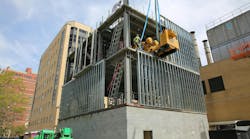Often, a building doesn't have its own electrical service, but is instead supplied by power from another building. In residential applications, you'll see this with structures such as detached garages and tool sheds. With commercial and industrial applications, you can add guard shacks, chemical storage, workshops, and many other types of buildings to the list.
One reason for powering one building from another is the one being powered presents too small a load to justify adding a service. For example, you have a guard shack with a 20A receptacle circuit, a window unit air conditioner, and baseboard electric heat. This same building illustrates another reason for this arrangement, and that is space. Do you really have room to pour a pad and mount a transformer for this building and each of three other little buildings located next to your plant?
If you use a branch or feeder from one building to supply power to another building, you generally can run only one branch or feeder for that purpose [225.30]. By "generally," we mean that there are five conditions under which you can exceed this limit [225.30(A) - (E)]:
- Special conditions
- Special occupancies
- Capacity requirements
- Different characteristics
- Documented switching procedures
We'll look at these conditions more closely in Part 2.


